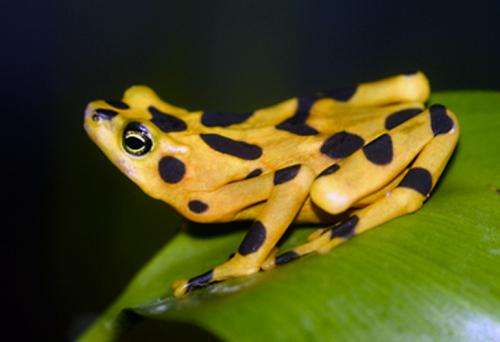Skin microbiome may hold answers to protect threatened gold frogs from lethal fungus

A team of scientists including Virginia Tech researchers is one step closer to understanding how bacteria on a frog's skin affects its likelihood of contracting disease.
A frog-killing fungus known as Batrachochytrium dendrobatidis, or Bd, has already led to the decline of more than 200 amphibian species including the now extinct-in-the-wild Panamanian golden frog.
In a recent study, the research team attempted to apply beneficial bacteria found on the skin of various Bd-resistant wild Panamanian frog species to Panamanian golden frogs in captivity, to see if this would stimulate a defense against the disease.
They found that while the treatment with beneficial bacteria was not successful due to its inability to stick to the skin, there were some frogs that survived exposure to the fungus.
These survivors actually had unique bacterial communities on their skin before the experiments started.
The results were published in the Proceedings of the Royal Society B.
The next step is to explore these new bacterial communities.
"We were disappointed that the treatment didn't work, but glad to have discovered new information about the relationship between these symbiotic microbial communities and amphibian disease resistance," said Lisa Belden, an associate professor of biological sciences in the College of Science, a Fralin Life Science Institute affiliate, and a faculty member with the new Global Change Center at Virginia Tech. "Every bit of information gets us closer to getting these frogs back into nature."
Studying the microbial communities of Panamanian golden frogs was the dissertation focus of Belden's former graduate student Matthew Becker, who graduated with a Ph.D. in biological sciences from Virginia Tech in 2014 and is now a fellow at the Smithsonian Conservation Biology Institute.
"Anything that can help us predict resistance to this disease is very useful because the ultimate goal of this research is to establish healthy populations of golden frogs in their native habitat," Becker told Smithsonian Science News. "I think identifying alternative probiotic treatment methods that optimize dosages and exposure times will be key for moving forward with the use of probiotics to mitigate chytridiomycosis."
Journal information: Proceedings of the Royal Society B
Provided by Virginia Tech


















